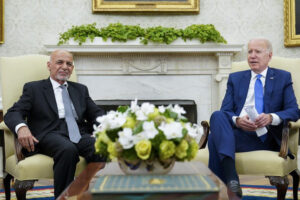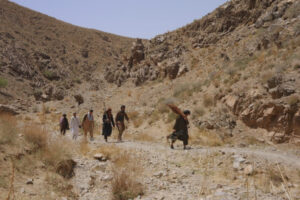The tottering ecosystem of anti-India militants and separatists in Kashmir has suffered two major setbacks, one after another, in the current week. Two of the most notable Kashmiri terrorists have been gunned down—one each in Afghanistan and Pakistan, raising speculations of group clashes and, as usual, whispers of an “Indian hand” by some politicians.
Top Islamic State functionary Aijaz Ahmad Ahangar has been found dead—reportedly killed by Taliban—in the Kunar Province of Afghanistan. The Jammu and Kashmir Police have received and shared this information with Ahangar’s elder brother in Srinagar.
Hizbul Mujahideen’s ‘Launching Chief’ Bashir Ahmad Peer has been shot dead by unidentified gunmen in his residential area of Rawalpindi, in Pakistan.
This is after a long time that any one of the Kashmiri militants has been killed, either in Afghanistan or Pakistan.
Both Ahangar and Peer, who had joined militancy in early 1990s and had lived in Afghanistan and Pakistan for nearly 30 years, were over 50 years old and had a high profile in terrorist ranks. Both had been designated as individual terrorists by the Union Ministry of Home Affairs (MHA) respectively on 5 January, 2023, and 4 October, 2022. The MHA used its powers under clause (e) of sub section (1) of section 35 of the Unlawful Activities (Prevention) Act, 1967.
The IS has killed dozens of Taliban members in recent months, in an accelerating intra-jihadist power struggle. According to a dossier, Ahangar was the architect of a March 2020 suicide bombing by Kasargod-born Muhammad Muhsin, who killed a security guard and 24 worshippers at the Gurdwara Kart-e Parwan in Kabul. He was believed to be responsible for a suicide attack involving Ijas Kallukettiya Purayil, a one-time dentist from Kerala’s Kasargod, at Jalalabad.
Aijaz Ahangar aka Imtiaz Alam was held in Afghanistan’s Kandahar in April 2020 along with IS Khurasan chapter (IS-K) chief Aslam Farooqui and charged with killing 27 Sikh worshippers a month earlier. He was believed to be among the detainees who fled prison around the take-over by Taliban in August 2021. He is reportedly survived by his wife Rukhsana, and her two daughters, Sabira and Tooba, who were both born in Pakistan respectively in 1997 and 2001.
Ahangar’s first wife Rukhsana happens to be the daughter of the Tehreek-ul-Mujahideen founder-chief in Kashmir, Abdul Gani Dar of Russu, Budgam, aka Abdullah Gazali. A top cleric of Jamiat-e-Ahle-Hadith, Gazali (80) was found killed on 13 February 2020 inside the same community mosque at Maisuma Srinagar where another top Ahli-Hadith cleric Maulana Showkat Shah was killed in an IED blast on 8 April, 2011.
Gazali, an accused in Shah’s assassination, was arrested but subsequently released on bail. His autopsy report indicated that Gazali’s head had been fatally smashed with a thick iron bar. Unlike Gazali, Ahangar continued with his base in Pakistan and Afghanistan where Rukhsana gave birth to two of his sons. He reportedly married a Pakistani woman in the PoK and finally a Russian lady, Leena Aisha, whose ethnic-Tajik husband had been killed in the fighting in Afghanistan.
Ahangar’s son Umais and son-in-law Huzaifa-al-Bakistani, who both joined IS ranks, were reportedly killed in Afghanistan.
According to an intelligence dossier, Ahangar was arrested by the Jammu and Kashmir Police in 1992 but he was soon released on bail. As part of a 40-recruit group, he was sent to a guerrilla training centre at Miranshah in Pakistan’s Khyber-Pakhtunkhwa province, where he received six weeks’ training in the use of automatic weapons and explosives. Ahangar was hugely influenced Fazal-ul-Rehman Khalil’s Jamia Uloom-ul-Islamia seminary in Karachi and Harkat-ul-Mujahideen which was closely linked to Afghan jihad patriarch Jalaluddin Haqqani, as well as al-Qaeda’s Osama bin Laden.
Following his release from prison in 1995, Ahanger was married to the Tehreek-ul-Mujahideen supremo Dar’s daughter Rukhsana. For some time he worked at his father’s foundry in Srinagar and the couple settled in the PoK in 1996.
Ahanger, an intelligence source said, worked at the Harkat-ul-Mujahideen’s office in Islamabad, editing its magazine Shahadat. To supplement his income, the source said, Ahanger also ran a small stationery store in Rawalpindi. On one occasion, Rukhsana returned to Srinagar on fake travel documents via Kathmandu but she was arrested and detained for 5 years.
After the couple gave birth to two sons, Abdullah Ibn-Aijaz and Abdul Rahman, Ahangar married Saira Yusuf, the wife of a slain al-Qaeda jihadist. In 2010, Ahangar moved to Miranshah to join the network of jihadist warlord Muhammad Illyas Kashmiri. Illyas — a veteran of the jihad in Kashmir who then joined al-Qaeda — had become a magnet for Indian jihadists, including Indian Mujahideen commander Riyaz Shahbandri and key 26/11 perpetrator David Headley.
Following a crackdown on Illyas in 2014 by the Pakistan Army, Ahangar and his family fled across the border into Afghanistan’s Paktia province. There, he joined a circle of jihadists around Hafiz Saeed Khan, a Pakistani jihadist who later founded the Islamic State in Afghanistan. The new organisation drew significant numbers of recruits from across the region, including some from Bangladesh, Pakistan and Maldives.
Early in its existence, the Islamic State repeatedly clashed with the Taliban over revenues and territorial control. Saira Yusuf and Ahanger’s younger son are believed to have been kidnapped in one such clash. The two daughters and Rukhsana are believed to have rejoined Ahanger soon after.
Taliban chief Hibatullah Akhundzada signed a peace agreement with the Islamic State in 2017, with Hafiz Saeed Khan’s successor, Aslam Farooqi. The agreement was brokered by Jalaluddin Haqqani’s son, Sirajuddin Haqqani, an internationally designated terrorist who is now Afghanistan’s interior minister.
Following the agreement, Ahanger was given charge of a new Islamic State unit set up to stage attacks against India-linked targets. The Pakistani jihadist Amir Sultan Huzaifa — married to Ahanger’s daughter Sabira — was given charge of publishing the Islamic State’s magazine, Sawt al-Hind. In 2020, Ahangar and Aslam Farooqi were arrested by the Afghan intelligence from a safe house in Kandahar. Farooqi was found killed in mysterious circumstances in 2022.
Like Ahangar, Bashir Ahmad Peer of Babapora (Aloosa), a village in Kralpora area of Kupwara in Kashmir, had shifted his base permanently to PoK and Pakistan in early 1990s. The MHA notification dated 4 October, 2022, described him as involved in recruitment and launching of Hizbul Mujahideen’s cadres besides “a number of online propaganda groups to unite ex-militants and other cadres for the furtherance of activities of Hizb-ul-Mujahideen, Lashkar-e-Toiba and others”.
As per terror Telegram channels, Peer was accused of getting Zakir Moosa, the founder-chief of Ansar Gazwat-ul-Hind, an offshoot of al-Qaeda in Kashmir, killed on May 23, 2019. In May 2017, Moosa had deserted Hizbul Mujahideen, launched AGH and declared to establish ‘Islamic State’ in Kashmir. According to a dossier, Peer was detained in March 2017 by the Pakistan Army’s Military Intelligence Directorate after he sent a 12-men unit to reinforce his ‘northern division commander’ Mohammad Shafi Dar. However, he was released shortly thereafter.
While Peer’s father died in Kupwara, he managed shifting of his entire family, including his mother, wife and children, from Kashmir to Pakistan and operated from there as Hizbul Mujahideen’s launching chief.
Nearly 50 guerrilla organisations and over 50 individuals based in Pakistan have been designated as terrorist organisations/individuals by the MHA under UAPA after 2019. They include the alleged architect of the Mumbai blasts of 1993 Dawood Ibrahim, Lashkar-e-Tayyiba ideologue Hafiz Saeed, Jaish-e-Mohammad supremo Masood Azhar and a number of their relatives and associates, besides Hizbul Mujahideen chief Syed Salahuddin and Al-Umar Mujahideen founder-chief Mushtaq Zargar alias Latram who, with Masood Azhar, was released in exchange for the hostages of an Indian Airlines flight IC-814 in December 1999.
source: indianarrative
















